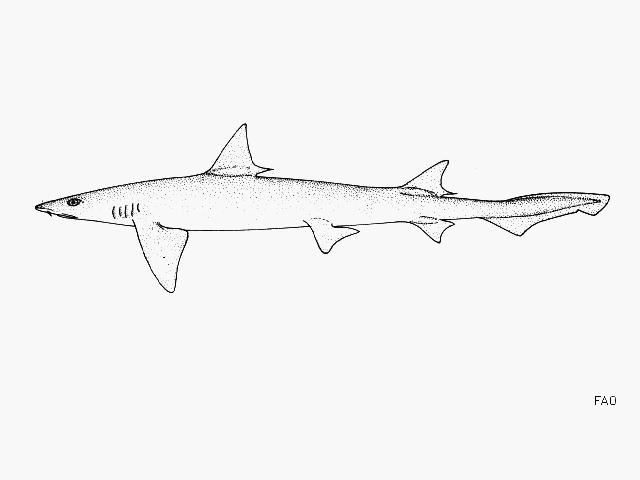Leptocharias smithii
(Müller & Henle, 1839)
Barbeled houndshark
Classification: Elasmobranchii Carcharhiniformes Leptochariidae
Reference of the original description
Systematische Beschreibung der Plagiostomen. Berlin, Veit, pp. 1–200
Systematische Beschreibung der Plagiostomen. Berlin, Veit, pp. 1–200
Image of the original description
.jpg)
Leptocharias smithii (Müller & Henle, 1839)
.jpg)
Leptocharias smithii (Müller & Henle, 1839)
Synonyms / new combinations and misspellings
Leptocharias smithi, Mustelus osborni, Triaenodon smithii
Leptocharias smithi, Mustelus osborni, Triaenodon smithii
Description :
Citation: Leptocharias smithii (Müller & Henle, 1839): In: Database of modern sharks, rays and chimaeras, www.shark-references.com, World Wide Web electronic publication, Version 04/2024
Please send your images of "Leptocharias smithii" to info@shark-references.com

Leptocharias smithii (Müller & Henle, 1839), © FAO, www.fish-base.org

Leptocharias smithii (Müller & Henle, 1839), © FAO, www.fish-base.org
Common names
 Gallo,
Gallo,  Marajo,
Marajo,  Tiburón barbudo,
Tiburón barbudo,  Chien de mer roux,
Chien de mer roux,  Emissole barbue,
Emissole barbue,  Requin,
Requin,  Émissole à grandes lèvres,
Émissole à grandes lèvres,  Barbeled hound shark,
Barbeled hound shark,  Barbeled houndshark,
Barbeled houndshark,  Barbelled houndshark,
Barbelled houndshark,  Cação-corre-corre,
Cação-corre-corre,  Tubarão-barbudo
Tubarão-barbudo
 Gallo,
Gallo,  Marajo,
Marajo,  Tiburón barbudo,
Tiburón barbudo,  Chien de mer roux,
Chien de mer roux,  Emissole barbue,
Emissole barbue,  Requin,
Requin,  Émissole à grandes lèvres,
Émissole à grandes lèvres,  Barbeled hound shark,
Barbeled hound shark,  Barbeled houndshark,
Barbeled houndshark,  Barbelled houndshark,
Barbelled houndshark,  Cação-corre-corre,
Cação-corre-corre,  Tubarão-barbudo
Tubarão-barbudo
Short Description
Similar to species of Mustelus but nostrils with anterior flaps formed into distinct barbels [20040].
Similar to species of Mustelus but nostrils with anterior flaps formed into distinct barbels [20040].
Human uses
fisheries: minor commercial; price category: not marketed/unknown; price reliability:
fisheries: minor commercial; price category: not marketed/unknown; price reliability:
Biology
Viviparous, placental [733], with 7 young in a litter [517]. Distinct pairing with embrace [17086]. Found on the continental shelf, especially abundant off river mouths on muddy bottoms. Salinity: 35-36 ppt. Oxygen: 3-4 ppm. Feeds on small bottom and littoral organisms like crustaceans, bony fishes, octopi and sponges.
Viviparous, placental [733], with 7 young in a litter [517]. Distinct pairing with embrace [17086]. Found on the continental shelf, especially abundant off river mouths on muddy bottoms. Salinity: 35-36 ppt. Oxygen: 3-4 ppm. Feeds on small bottom and littoral organisms like crustaceans, bony fishes, octopi and sponges.
Remarks
shark-references Species-ID=3478;
shark-references Species-ID=3478;
Parasites (arranged by Jürgen Pollerspöck)
Copepoda
Copepoda
- Driocephalus cerebrinoxius (Diebakate, Raibaut & Kabata, 1997) [14630]
- Eudactylina leptochariae Diebakate & Raibaut, 2000 [21208]















